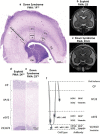Assessment of radial glia in the frontal lobe of fetuses with Down syndrome
- PMID: 32819430
- PMCID: PMC7441567
- DOI: 10.1186/s40478-020-01015-3
Assessment of radial glia in the frontal lobe of fetuses with Down syndrome
Abstract
Down syndrome (DS) occurs with triplication of human chromosome 21 and is associated with deviations in cortical development evidenced by simplified gyral appearance and reduced cortical surface area. Radial glia are neuronal and glial progenitors that also create a scaffolding structure essential for migrating neurons to reach cortical targets and therefore play a critical role in cortical development. The aim of this study was to characterise radial glial expression pattern and morphology in the frontal lobe of the developing human fetal brain with DS and age-matched controls. Secondly, we investigated whether microstructural information from in vivo magnetic resonance imaging (MRI) could reflect histological findings from human brain tissue samples. Immunohistochemistry was performed on paraffin-embedded human post-mortem brain tissue from nine fetuses and neonates with DS (15-39 gestational weeks (GW)) and nine euploid age-matched brains (18-39 GW). Radial glia markers CRYAB, HOPX, SOX2, GFAP and Vimentin were assessed in the Ventricular Zone, Subventricular Zone and Intermediate Zone. In vivo diffusion MRI was used to assess microstructure in these regions in one DS (21 GW) and one control (22 GW) fetal brain. We found a significant reduction in radial glial progenitor SOX2 and subtle deviations in radial glia expression (GFAP and Vimentin) prior to 24 GW in DS. In vivo, fetal MRI demonstrates underlying radial projections consistent with immunohistopathology. Radial glial alterations may contribute to the subsequent simplified gyral patterns and decreased cortical volumes observed in the DS brain. Recent advances in fetal MRI acquisition and analysis could provide non-invasive imaging-based biomarkers of early developmental deviations.
Keywords: Cortical development; Diffusion MRI; Down syndrome; Fetal brain; Radial glia; SOX2.
Conflict of interest statement
The authors declare that they have no competing interests.
Figures






References
Publication types
MeSH terms
Grants and funding
LinkOut - more resources
Full Text Sources
Medical
Research Materials
Miscellaneous

